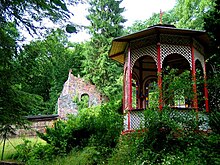tea house


The tea house is a design element of landscape architecture - especially in Japan , China and Europe in the 18th century. Usually it is a solitary pavilion.
Europe
Tea houses were part of the fashionable China enthusiasm of the Baroque . Outstanding examples are the tea room in the Pagodenburg of Nymphenburg Palace in Munich or the Chinese tea house in Sanssouci Park in Potsdam . Many nobles and wealthy citizens imitated the grandiose models. Other well-known teahouses in Germany are in Weißenburgpark in Stuttgart, in Frankfurt am Main ( Kengo Kumas Teehaus) and in Darmstadt .
Chinese and Japanese tea houses are often gifts from partner cities in German-speaking countries . In 2009, for example, Hamburg imported the building material for a tea house from its twin city Shanghai and installed it behind the ethnological museum .
Asia
The role models, the teahouses of Asia , especially China and Japan , have a very old tradition:
China
Political influences in the 20th century slowed the Chinese tea culture , so that many public teahouses had to close. In Taiwan, but also in many families on the mainland, the traditions have been preserved and passed on from generation to generation. In contrast to the Japanese tea houses, the Chinese tea houses are usually lavishly decorated. Chinese teahouses are a place to socialize, and there are often newspaper sellers and shoe shiners. A special Chinese ritual is the art of pouring tea water from a jug with a long pipe spout .
Japan
Main article: Japanese tea ceremony # tea house
In Japan, the deliberately simply furnished tea houses are used for the tea ceremony , a special form of expression of Japanese culture. The typical Japanese tea house is surrounded by a small Japanese garden , often with a water basin. The simple, but nevertheless very tasteful design of the Japanese teahouses goes back to Sen no Rikyū , who represented the teaching of Wabi-Cha , the aesthetics of the simple, unfinished and asymmetrical. The tea house consists of several rooms, namely the anteroom (Mizuya), where the tea devices are stored, a waiting room (Machiai) in which the guests wait until they are allowed to enter the tea room, and the typical garden path ( Roji ), the tea room and Machiai connects and symbolizes the transition to another world. The heart of the tea room is the wall niche ( tokonoma ), which was originally created from Chinese altars.
Individual evidence
- ↑ Germany: Joy for all | TIME ONLINE . Website Zeit Online. Retrieved November 15, 2015.
- ↑ http://german.cri.cn/1833/2010/12/21/1s149340.htm
- ↑ Kakuzo Okakura: The Book of Tea. Transferred and with an afterword by Horst Hammitzsch. Frankfurt am Main: Insel 1979 ISBN 3-458-32112-8 , p. 56
literature
- William T. DeBary: Introduction to oriental civilizations . CUP, New York
- 1. Sources of the japanese tradition . 1971, ISBN 0-231-02254-9
- Rhoads Murphey: East Asia. A new history . Pearson / Longman, New York 2004, ISBN 0-321-16336-2
- Kakuzo Okakura : The Book of Tea . Transferred and with an afterword by Horst Hammitzsch . Frankfurt am Main: Insel 1979 ISBN 3-458-32112-8
- Morgan Pitelka: Japanese tea culture. Art, history and practice . Routledge Curzon Books, London 2003, ISBN 0-415-29687-0
- Paul Varley: Japanese Culture . 4th ed. Updated and Expanded. University of Hawaii Press, Honolulu 2000, ISBN 0-8248-2292-7
- Arend Vollers: Tee , Heyne Verlag 1996, ISBN 3-453-09379-8

